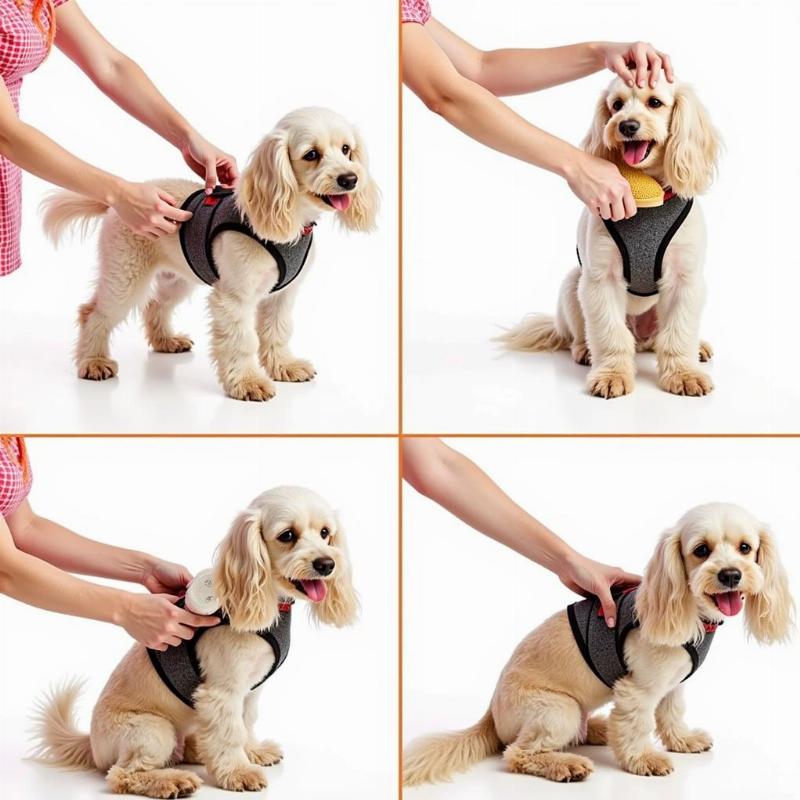Choosing the right harness for a long-haired dog requires careful consideration to ensure both comfort and safety. A poorly fitted harness can lead to matting, skin irritation, and even pain, especially for breeds with luxurious coats. This guide will help you navigate the world of dog harnesses and find the perfect fit for your furry friend.
Types of Harnesses for Long-Haired Dogs
There are several types of harnesses available, each with its own pros and cons for long-haired dogs. Understanding these differences is crucial for making an informed decision.
Back-Clip Harnesses
These harnesses have a leash attachment point on the dog’s back. While easy to use, they can encourage pulling, especially in strong breeds. For long-haired dogs, back-clip harnesses can cause matting and tangles around the shoulders and chest.
Front-Clip Harnesses
Front-clip harnesses attach to the leash on the dog’s chest. This design helps discourage pulling by gently steering the dog back towards you. They’re a good option for long-haired dogs as they distribute pressure more evenly, reducing the risk of matting.
Dual-Clip Harnesses
These versatile harnesses offer both front and back leash attachment points, providing flexibility for training and walking. They can be a good choice for long-haired dogs transitioning from pulling to loose-leash walking.
Step-In Harnesses
These harnesses are easy to put on, requiring the dog to step into the leg loops. However, they can be tricky for some dogs to get used to and might not be ideal for dogs with mobility issues. For long-haired dogs, step-in harnesses can sometimes tangle long fur around the legs.
Choosing the Right Material and Fit
For long-haired dogs, breathable and lightweight materials are essential to prevent overheating and skin irritation. Mesh harnesses are a popular choice, offering good ventilation and comfort. Avoid harnesses made of rough or abrasive materials that can snag or damage the coat.
Proper fit is paramount. A harness that’s too tight can cause discomfort and restrict movement, while a loose harness can lead to chafing and escape attempts. Measure your dog’s chest and girth accurately and consult the manufacturer’s sizing chart to ensure a perfect fit.
Best Practices for Using a Harness with Long-Haired Dogs
Regularly check the harness for any signs of wear and tear, especially around the straps and buckles. Clean the harness according to the manufacturer’s instructions to maintain hygiene and prevent skin irritation.
Grooming and Harness Care
Regular grooming is essential for long-haired dogs wearing harnesses. Brushing the coat before and after each walk helps prevent mats and tangles. Consider using a detangling spray or conditioner to keep the fur smooth and manageable.
Addressing Common Concerns
My dog’s harness is causing matting. What should I do?
Switch to a harness made of smoother, more breathable material and ensure a proper fit. Regular grooming and the use of detangling products can also help.
My dog keeps slipping out of their harness.
Check the fit and adjust the straps as needed. Consider a different harness style, such as a dual-clip harness, which offers more control.
 Grooming a Long-Haired Dog Wearing a Harness
Grooming a Long-Haired Dog Wearing a Harness
Conclusion
Finding the perfect harness for long haired dogs involves considering their breed, coat type, and activity level. Prioritizing comfort, safety, and proper fit will ensure a positive experience for both you and your furry companion. Remember to choose breathable materials, check the fit regularly, and maintain a consistent grooming routine. With the right harness, you can enjoy countless comfortable and safe walks with your long-haired friend.
FAQ
- What type of harness is best for a long-haired dog that pulls? A front-clip harness can help discourage pulling and reduce strain on the dog’s coat.
- How often should I clean my dog’s harness? Clean the harness at least once a month, or more frequently if it becomes soiled.
- Can I use a harness on a puppy with long hair? Yes, but choose a lightweight and adjustable puppy harness designed for growing dogs.
- What material is best for a long-haired dog’s harness in hot weather? Mesh or other breathable materials are ideal for preventing overheating.
- How do I prevent matting around my dog’s harness? Regular brushing, detangling sprays, and a properly fitted harness can help prevent matting.
- Are there harnesses specifically designed for long-haired breeds? While not breed-specific, certain harness styles and materials are better suited for long-haired dogs.
- What should I do if my dog’s harness is rubbing their skin? Adjust the fit or switch to a softer material. Consult a veterinarian if the irritation persists.
Related Articles
- best harness for long haired dogs
- best dogs for hiking and running
- what to do with dogs when it's too hot
- waterproof dog coat with built in harness
Beautdogs.us is your premier online destination for all things dog-related in the US. We offer expert advice on dog breeds, grooming, training, and health, along with a curated selection of products and services tailored to the American dog owner. Whether you’re a seasoned dog parent or just starting your journey, Beautdogs.us provides trustworthy information and resources to help you and your furry friend thrive. Contact us at [email protected] or +1 501-555-7529 for personalized assistance.